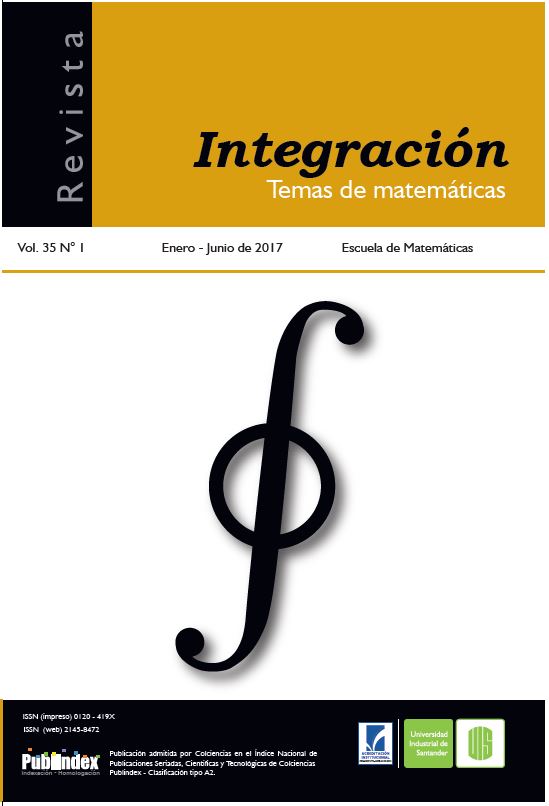Research and Innovation Articles
Published 2017-08-08
Keywords
- Maximum principle,
- critical points,
- connected component,
- symmetry
How to Cite
Arango, J., Jiménez, J., & Salazar, A. (2017). Critical points and symmetries in elliptic problems. Revista Integración, Temas De matemáticas, 35(1), 1–9. https://doi.org/10.18273/revint.v35n1-2017001
Abstract
In this paper we estimate an upper bound for the number of critical points of the solution to a semilinear elliptic problem with vanishing Dirichlet condition on a bounded planar domain. The result is obtained assuming that the domain is symmetric with respect to a line and convex in the orthogonal direction to the line of symmetry.
MSC2010: 35J25, 35J91, 74K15.
Downloads
Download data is not yet available.
References
[1] Alessandrini G., “Critical points of solutions of elliptic equations in two variables”, Ann.Sc. Norm. Super. Pisa Cl. Sci. (5) 14 (1987), No. 2, 229–256.
[2] Arango J. and Gómez A., “Critical points of solutions to elliptic problems in planar domains”, Commun. Pure Appl. Anal. 10 (2011), No. 1, 327–338.
[3] Arango J. and Gómez A., “Critical points of solutions to quasilinear elliptic problems”, Nonlinear Anal. 75 (2012), No. 11, 4375–4381.
[4] Cabré X. and Chanillo S., “Stable solutions of semilinear elliptic problems in convex domains”, Selecta Math. (N.S.) 4 (1998), No. 1, 1–10.
[5] Caffarelli L. and Spruck J., “Convexity properties of solutions to some classical variational problems”, Comm. Partial Differential Equations 7 (1982), No. 11, 1337–1379.
[6] Cheng S., “Eigenfunctions and nodal sets”, Comment. Math. Helv. 51 (1976), No. 1, 43–55.
[7] Chipot M., Elliptic equations: an introductory course, Birkhäuser Advanced Texts: Basler Lehrbücher. Birkhäuser Verlag, Basel, 2009.
[8] Duren P., Harmonic mappings in the plane, Cambridge Univ. Press, Cambridge, 2004.
[9] Finn D., “Convexity of level curves for solutions to semilinear elliptic equations”, Commun. Pure Appl. Anal. 7 (2008), No. 6, 1335–1343.
[10] Greco A., “Extremality conditions for the quasi-concavity function and applications”, Arch. Math. (Basel) 93 (2009), No. 4, 389–398.
[11] Kawohl B., “When are solutions to nonlinear elliptic boundary value problems convex?”, Comm. Partial Differential Equations 10 (1985), No. 10, 1213–1225.
[12] Makar-Limanov L., “Solution of Dirichlet’s problem for the equation u = −1 in a convex region”, Math. Notes 9 (1971), No. 1, 52–53.
[13] Müller F., “On the continuation of solutions for elliptic equations in two variables”, Ann. Inst. H. Poincaré Anal. Non Linéaire 19 (2002), No. 6, 745–776.
[14] Rivera A., “Puntos críticos de soluciones de problemas elípticos con condición de Dirichlet”, Tesis de maestría, Universidad del Valle, Cali, 2006, 57 p.
[15] Sakaguchi S., “Concavity properties of solutions to some degenerate quasilinear elliptic Dirichlet problems”, Ann. Sc. Norm. Super. Pisa Cl. Sci. (5) 14 (1987), No. 3, 403–421.
[16] Pucci P. and Serrin J., The maximum principle, Birkhäuser Verlag, Basel, 2007.
[2] Arango J. and Gómez A., “Critical points of solutions to elliptic problems in planar domains”, Commun. Pure Appl. Anal. 10 (2011), No. 1, 327–338.
[3] Arango J. and Gómez A., “Critical points of solutions to quasilinear elliptic problems”, Nonlinear Anal. 75 (2012), No. 11, 4375–4381.
[4] Cabré X. and Chanillo S., “Stable solutions of semilinear elliptic problems in convex domains”, Selecta Math. (N.S.) 4 (1998), No. 1, 1–10.
[5] Caffarelli L. and Spruck J., “Convexity properties of solutions to some classical variational problems”, Comm. Partial Differential Equations 7 (1982), No. 11, 1337–1379.
[6] Cheng S., “Eigenfunctions and nodal sets”, Comment. Math. Helv. 51 (1976), No. 1, 43–55.
[7] Chipot M., Elliptic equations: an introductory course, Birkhäuser Advanced Texts: Basler Lehrbücher. Birkhäuser Verlag, Basel, 2009.
[8] Duren P., Harmonic mappings in the plane, Cambridge Univ. Press, Cambridge, 2004.
[9] Finn D., “Convexity of level curves for solutions to semilinear elliptic equations”, Commun. Pure Appl. Anal. 7 (2008), No. 6, 1335–1343.
[10] Greco A., “Extremality conditions for the quasi-concavity function and applications”, Arch. Math. (Basel) 93 (2009), No. 4, 389–398.
[11] Kawohl B., “When are solutions to nonlinear elliptic boundary value problems convex?”, Comm. Partial Differential Equations 10 (1985), No. 10, 1213–1225.
[12] Makar-Limanov L., “Solution of Dirichlet’s problem for the equation u = −1 in a convex region”, Math. Notes 9 (1971), No. 1, 52–53.
[13] Müller F., “On the continuation of solutions for elliptic equations in two variables”, Ann. Inst. H. Poincaré Anal. Non Linéaire 19 (2002), No. 6, 745–776.
[14] Rivera A., “Puntos críticos de soluciones de problemas elípticos con condición de Dirichlet”, Tesis de maestría, Universidad del Valle, Cali, 2006, 57 p.
[15] Sakaguchi S., “Concavity properties of solutions to some degenerate quasilinear elliptic Dirichlet problems”, Ann. Sc. Norm. Super. Pisa Cl. Sci. (5) 14 (1987), No. 3, 403–421.
[16] Pucci P. and Serrin J., The maximum principle, Birkhäuser Verlag, Basel, 2007.
